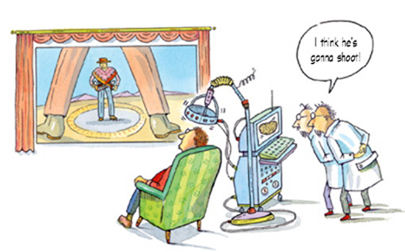A rose is a rose is a rose; but do we, the artist and the poet all see the same flower in the same way?
This age-old philosophical question has now been put to the test by scientists at the Weizmann Institute.
While no one can actually “get inside” the head of another, for neurobiologists, modern biological imaging methods such as fMRI are the next best thing. The f stands for “functional,” meaning that the magnetic images record changes in the brain’s blood flow while it is in the process of thinking or experiencing, responding to stimuli or performing set tasks, allowing scientists to accurately pinpoint the areas involved in each function.
To compare individual perceptions of visual experiences, Prof. Rafael Malach and Uri Hasson, along with their colleagues in the Neurobiology Department, showed volunteers a segment of a movie (in this case, the classic Western The Good, the Bad and the Ugly) while they were undergoing brain scans with fMRI.
The scans allowed the scientists to see which areas of the subjects’ brains were active during love scenes or gunfights. Because a movie offers a wealth of different visual stimuli - scenery, faces, action, etc. - the researchers were able to track the brains’ response to a rich, dynamic scene. A change in experimental stimuli turned up surprising results. Rather than showing the subjects carefully selected slides or photos - the typical visual stimuli used in such experiments - the researchers showed them a movie. Essentially, rather than presenting one type of stimulus and then looking for the response, the brain areas themselves were allowed to select their own fare from a smorgasbord of possibilities, and the scientists then took note of the brain’s selections.
What they found was a striking similarity between brain activity patterns in all the subjects; so much so that the patterns of one brain could be used to predict activity in other brains when viewing the same segment. “Despite our strong sense of individuality, such a high level of agreement among subjects implies that our brains ‘tick together’ when exposed to the same visual environment,” says Malach.
Interestingly however, the brain scans also revealed that within an individual brain, different regions are active in viewing different parts of the movie. Because each area is activated by a specific kind of visual cue, it only picks up on those bits that “speak” directly to its specialized preference. For instance, a region known to be involved with face recognition lights up only when close-ups appear on the screen, while scenery elicits a response from another part of the brain that helps us navigate in three-dimensional space. The scientists noted a third area that seemed to be activated when actors performed delicate hand motions. They believe this last area may be part of a network of brain regions used to understand the actions and intentions of others. “While you perceive a single, whole movie, different regions of your brain are each processing a private motion picture of their own,” says Malach. “The unified percept you experience is, in fact, the result of a tremendous ‘jam session’ played by many different, highly specialized brain areas.”

Prof. Malach’s research is supported by the Nella and Leon Benoziyo Center for Neurosciences; the Murray H. and Meyer Grodetsky Center for Research of Higher Brain Functions; the Norman and Helen Asher Center for Brain Imaging; the Edith C. Blum Foundation Inc.; the Mary Ralph Designated Philanthropic Fund and the James S. McDonnell Foundation.
